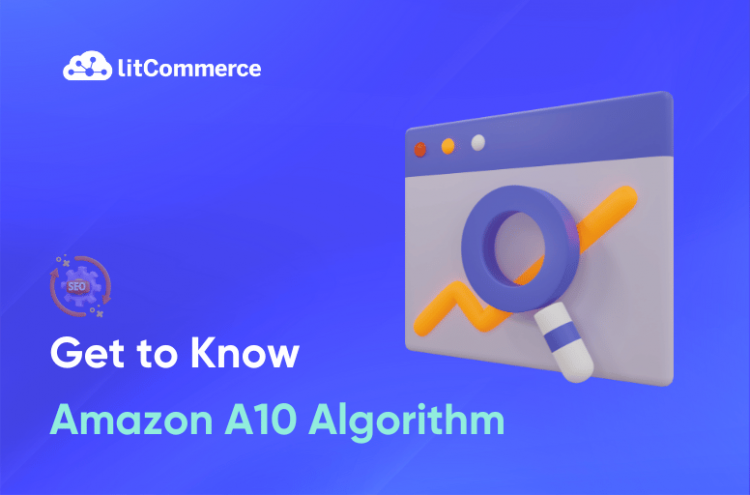As a seller on one of the world’s largest eCommerce platforms, you know that visibility is everything. That’s when you should pay more attention to the Amazon A10 algorithm, working behind the scenes to determine how your products rank and appear in those coveted search results. So, welcome to the world of the A10 algorithm,
In this discussion, we’re going to be your trusty guides, helping you navigate through the ins and outs of the Amazon A10 algorithm and 7 factors (both new and old) of the Amazon A10 algorithm:
- Sales performance
- Product listing optimization
- Conversion rate
- Click through rate
- Seller authority
- Customer reviews & feedback
- Off-site source traffic and sales
Let’s get started!
Understanding Amazon A10 Algorithm
Amazon marketplace currently uses the A10 algorithm to rank products in search results. If you know how the A10 algorithm operates, you can “manipulate” it to boost your product’s visibility and sales.

What is Amazon A10 Algorithm?
The Amazon A10 algorithm is the latest version of Amazon’s search engine, responsible for ranking products on their website. It uses artificial intelligence (AI) and machine learning to determine which products appear first in search results when a customer enters a query.
How does A10 algorithm work?
The Amazon 10 algorithm ranks products by giving them scores based on how relevant they are to customer searches, product descriptions, and other factors. Products with higher scores show up higher in the search results. This helps customers find what they want quickly, and the algorithm gets better over time as it learns from more data. The details it looks at include things like:
- Front-end keywords
- Sales performance
- Conversion rates
- Backend keywords
- Seller’s authority
- Customer reviews
- Click-through rates
For Amazon sellers, the A10 algorithm offers a chance to boost their product listings and sales.
To do well with the new algorithm, sellers should focus on building a good reputation, improving product quality, getting higher click-through rates, and bringing in traffic from other websites. Reviews, ratings, and social media mentions also help increase sales.
By paying attention to these factors, sellers can stand out in the competitive Amazon marketplace and make more money.
The Differences Between Amazon A9 and A10 Algorithm
The Amazon A9 algorithm came before the A10. It worked similarly but prioritized different factors and didn’t consider some of the things the A10 looks at.
The A10 algorithm focuses more on external signals like reviews, ratings, and social media mentions. Meanwhile, the A9 algorithm mainly used internal data like sales history and conversion rates to determine relevance. This change helps Amazon’s algorithm better understand how customers interact with products on and off the platform. Then, it can suggest the right products.
7 Factors that Affect the A10 Amazon Algorithm
The A10 algorithm is complex, but understanding the key factors it considers can significantly improve your product’s ranking and visibility. Here are 7 aspects that influence your placement in Amazon search results:
#1. Sales performance
Sales performance is key to your product’s ranking on Amazon. The A10 algorithm looks at sales metrics to determine your products’ popularity and relevance. Knowing how sales affect the algorithm lets you boost your product’s visibility and sales. When maintaining a good sales performance, you need to factor in 2 aspects: organic sales & internal sales.
1. Organic sales
Organic sales are purchases generated through natural product visibility and customer interest without the use of paid advertising. Consistent organic sales tell the A10 algorithm that your product is relevant to customer searches and that there’s genuine customer demand for it. This strongly indicates that your product should be shown prominently in search results.
Tips:
- Optimize your product listings with relevant keywords, clear descriptions, high-quality images, and competitive pricing to attract organic sales.
- Improve product reviews to encourage other shoppers to choose your product organically. You can do it by offering prompt and professional customer experience.

2. Sales velocity
Sales velocity refers to the rate at which products are sold over a certain period of time. On Amazon, sales velocity measures how quickly a product is moving in terms of units sold, total revenue, or both. Amazon’s A10 algorithm prioritizes products that have higher sales velocity because it assumes that products selling well are likely more appealing to customers. The A10 algorithm considers multiple factors to determine the ranking of a product, and sales velocity is a crucial one.
Tips:
- Keep an eye on market prices and consider offering occasional discounts or coupons to boost sales.
- Use FBA can improve sales velocity by offering faster shipping and Amazon Prime eligibility, which customers often prefer.
#2. Product listing optimization
Product listing optimization is an important factor in the Amazon A10 algorithm as it helps improve the visibility and ranking of products in search results. Actually, there are a lot of aspects to execute Amazon listing optimization. However, this article emphasizes two most outstanding elements, including keywords and Amazon PPC.
1. Keyword
Optimizing your product listing with the right keywords greatly enhances your chances of ranking higher in search results. The Amazon A10 algorithm carefully analyzes keywords that appear in various parts of your product listing content, such as titles, bullet points, descriptions, and backend search terms.
Hence, to signal the Amazon A10, you should do thorough keyword research to discover your potential customers’ search terms and phrases. Then, you can distribute them across your product title, bullet points, description, and backend keywords.
Tips:
- Avoid overstuffing your product titles and descriptions with top-performing keywords. Instead, focus on creating clear, informative listings that accurately represent your product.
2. Amazon PPC
After the Amazon A10 update, rumors suggested that organic sales became more important than Sponsored Ads for Amazon SEO. However, while relevance is now a key factor, Amazon Advertising is still factored in. Amazon PPC campaigns remain essential for boosting your long-term sales strategy.
Tips:
- Run PPC campaigns to boost new products or improve underperforming listings.
- Use display PPC ads for products that are most likely to convert.
- Combine ads with promotions to attract more customers.
#3. Conversion rate
This measures how many customers click on your product listing and make a purchase. A high conversion rate shows that your listing successfully convinces customers that your product meets their needs. And this will signal to the A10 algorithm that your product works well and deserves a high ranking.
Tips:
- Maintain a competitive price for your product
- Enhance your listing with A+ Content to make it more appealing
- Maintain a high seller rating and positive product reviews to build trust with potential customers
#4. Click through rate
The Click-Through Rate (CTR) measures how many clicks your product receives when shown on a search results page. It plays a crucial role in determining the relevance of the A10 algorithm. As more people click on your listing and find it relevant, you’re more likely to see an increase in organic purchases. Hence, to improve CTE, you should invest more on the title, image, and initial description.
Tips:
- Ensure your product information is clear, concise, and addresses potential customer concerns.
- Offer competitive pricing and consider using promotions or discounts to encourage clicks and purchases.
- Use high-resolution and professional photos for the main image since it appears on search results.
#5. Seller authority
Seller authority refers to a merchant’s performance history on Amazon. A seller with a good reputation, high rating, and track record is likelier to get a higher relevancy score. Seller authority also means that being on Amazon for a longer time is better than being new. Additionally, having a low return rate and handling returns efficiently are essential factors.
Tips:
- Provide excellent customer service, answer questions promptly, and resolve issues efficiently.
- Ensure your product descriptions are clear and accurate, and package your items well to avoid damage and lower the return rate.
- Process returns quickly and professionally.
#6. Customer reviews & feedback
With the Amazon A10 update, happy customers and good feedback are still key factors in ranking. Having many positive reviews and high ratings gives your product social proof and encourages the A10 algorithm to rank your products higher in search results. Therefore, Amazon sellers should be persistent in seeking reviews.
Tips:
- Ensure your products meet or exceed customer expectations.
- Respond to customer inquiries and resolve issues promptly.
- Include a card with your product asking for feedback and reviews if you fulfill orders yourself.
#7. Off-site source traffic and sales
Last but not least, traffic and sales from outside of Amazon now have a greater impact on your product ranking than ever before. This off-site traffic can come from your website, social media, email campaigns, influencer partnerships, and targeted ads. These external factors can signal to A10 that the product is relevant and on-demand, which means it deserves a higher ranking in search results.
Tips:
- Create valuable content for your target audience and share it on social media or blog to drive traffic to your Amazon listings.
- Optimize product descriptions and off-site content with relevant keywords to increase organic search visibility and potential customer discovery.
Partner with influencers to promote your products and reach a larger audience. - Feature Amazon product links on your website to guide visitors to your Amazon listings.
- Use email marketing with direct links to your Amazon products.
- Invest in ads on platforms like Google and Facebook to attract potential buyers to your Amazon listings.
Amazon A10 Algorithm – FAQs
The inner workings of the A10 algorithm are a closely guarded secret by Amazon, but here’s what we know about how it influences product ranking in search results. A10 leverages machine learning to analyze vast amounts of data and continuously improve its ranking accuracy. The algorithm prioritizes showing users products that are most relevant to their searches. It considers various onsite and offsite factors to determine this relevancy. The Amazon A10 algorithm determines product rankings based on these 7 main factors to rank products and enhance customer experience, includings:
Level Up Your Listing Ranking with Amazon A10 Algorithm!
You now have all the valuable insights into what is the Amazon A10 Algorithm and how it works. With this knowledge, you can better navigate the online marketplace and boost your products to new success! Remember, the A10 Algorithm is not a mystical force beyond your understanding. It’s your ally, working with you to create a delightful shopping experience for Amazon customers.
If you’re interested in exploring multichannel selling, look no further than LitCommerce. Feel free to reach out to us for in-depth discussions about how we can support your journey. Additionally, we have more exciting articles lined up on our Retailer Blog to help you succeed in this ever-changing eCommerce industry. Join us now!



